231 polytope
The 231 is composed of 126 vertices, 2016 edges, 10080 faces (triangles), 20160 cells (tetrahedra), 16128 4-faces (4-simplexes), 4788 5-faces (756 pentacrosses, and 4032 5-simplexes), 632 6-faces (576 6-simplexes and 56 221). Its vertex figure is a 6-demicube. Its 126 vertices represent the root vectors of the simple Lie group E7.
This polytope is the vertex figure for a uniform tessellation of 7-dimensional space, 331 .
Alternate names
- E. L. Elte named it V126 (for its 126 vertices) in his 1912 listing of semiregular polytopes. [1]
- It was called 231 by Coxeter for its bifurcating Coxeter-Dynkin diagram, with a single ring on the end of the 2-node sequence.
- Pentacontahexa-pentacosiheptacontahexa-exon (Acronym: laq) - 56-576 facetted polyexon (Jonathan Bowers) [2]
Construction
It is created by a Wythoff construction upon a set of 7 hyperplane mirrors in 7-dimensional space.
The facet information can be extracted from its Coxeter-Dynkin diagram, 









 .
.
Removing the node on the short branch leaves the 6-simplex. There are 576 of these facets. These facets are centered on the locations of the vertices of the 321 polytope, 









 .
.
Removing the node on the end of the 3-length branch leaves the 221. There are 56 of these facets. These facets are centered on the locations of the vertices of the 132 polytope, 







 .
.
The vertex figure is determined by removing the ringed node and ringing the neighboring node. This makes the 6-demicube, 131, 







 .
.
Seen in a configuration matrix, the element counts can be derived by mirror removal and ratios of Coxeter group orders. [3]
| E7 |            | k-face | fk | f0 | f1 | f2 | f3 | f4 | f5 | f6 | k-figures | Notes |
|---|
| D6 |            | ( ) | f0 | 126 | 32 | 240 | 640 | 160 | 480 | 60 | 192 | 12 | 32 | 6-demicube | E7/D6 = 72x8!/32/6! = 126 |
|---|
| A5A1 |            | { } | f1 | 2 | 2016 | 15 | 60 | 20 | 60 | 15 | 30 | 6 | 6 | rectified 5-simplex | E7/A5A1 = 72x8!/6!/2 = 2016 |
|---|
| A3A2A1 |            | {3} | f2 | 3 | 3 | 10080 | 8 | 4 | 12 | 6 | 8 | 4 | 2 | tetrahedral prism | E7/A3A2A1 = 72x8!/4!/3!/2 = 10080 |
|---|
| A3A2 |            | {3,3} | f3 | 4 | 6 | 4 | 20160 | 1 | 3 | 3 | 3 | 3 | 1 | tetrahedron | E7/A3A2 = 72x8!/4!/3! = 20160 |
|---|
| A4A2 |            | {3,3,3} | f4 | 5 | 10 | 10 | 5 | 4032 | * | 3 | 0 | 3 | 0 | {3} | E7/A4A2 = 72x8!/5!/3! = 4032 |
|---|
| A4A1 |            | 5 | 10 | 10 | 5 | * | 12096 | 1 | 2 | 2 | 1 | Isosceles triangle | E7/A4A1 = 72x8!/5!/2 = 12096 |
| D5A1 |            | {3,3,3,4} | f5 | 10 | 40 | 80 | 80 | 16 | 16 | 756 | * | 2 | 0 | { } | E7/D5A1 = 72x8!/32/5! = 756 |
|---|
| A5 |            | {3,3,3,3} | 6 | 15 | 20 | 15 | 0 | 6 | * | 4032 | 1 | 1 | E7/A5 = 72x8!/6! = 72*8*7 = 4032 |
| E6 |            | {3,3,32,1} | f6 | 27 | 216 | 720 | 1080 | 216 | 432 | 27 | 72 | 56 | * | ( ) | E7/E6 = 72x8!/72x6! = 8*7 = 56 |
|---|
| A6 |            | {3,3,3,3,3} | 7 | 21 | 35 | 35 | 0 | 21 | 0 | 7 | * | 576 | E7/A6 = 72x8!/7! = 72×8 = 576 |
Images
Coxeter plane projections| E7 | E6 / F4 | B6 / A6 |
|---|

[18] | 
[12] | 
[7x2] |
| A5 | D7 / B6 | D6 / B5 |
|---|

[6] | 
[12/2] | 
[10] |
| D5 / B4 / A4 | D4 / B3 / A2 / G2 | D3 / B2 / A3 |
|---|

[8] | 
[6] | 
[4] |
| 2k1 figures in n dimensions |
|---|
| Space | Finite | Euclidean | Hyperbolic |
|---|
| n | 3 | 4 | 5 | 6 | 7 | 8 | 9 | 10 |
|---|
Coxeter
group | E3=A2A1 | E4=A4 | E5=D5 | E6 | E7 | E8 | E9 =  = E8+ = E8+ | E10 =  = E8++ = E8++ |
|---|
Coxeter
diagram |      |      |        |          |            |              |                |                  |
|---|
| Symmetry | [3−1,2,1] | [30,2,1] | [[31,2,1]] | [32,2,1] | [33,2,1] | [34,2,1] | [35,2,1] | [36,2,1] |
|---|
| Order | 12 | 120 | 384 | 51,840 | 2,903,040 | 696,729,600 | ∞ |
|---|
| Graph |  | 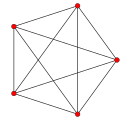 | 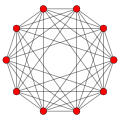 | 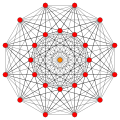 | 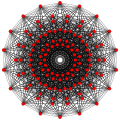 | 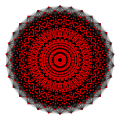 | - | - |
|---|
| Name | 2−1,1 | 201 | 211 | 221 | 231 | 241 | 251 | 261 |
|---|
This page is based on this
Wikipedia article Text is available under the
CC BY-SA 4.0 license; additional terms may apply.
Images, videos and audio are available under their respective licenses.
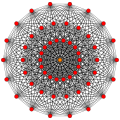






![]()
![]()
![]()
![]()
![]()
![]()
![]()
![]()
![]()
![]()
![]() .
.






















